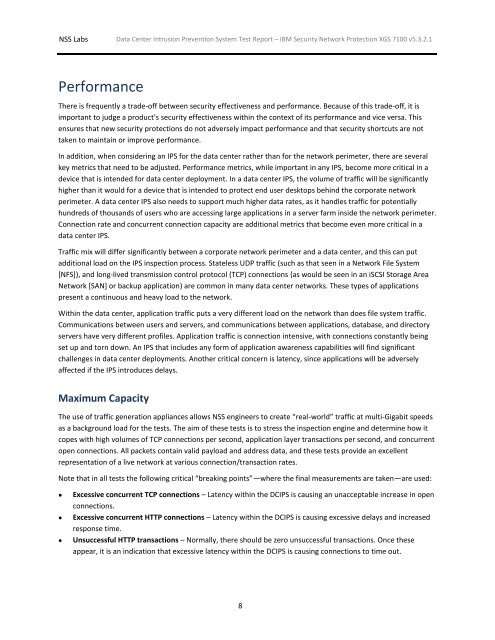NSS-Labs-Data-Center-IPS-Test-Report
You also want an ePaper? Increase the reach of your titles
YUMPU automatically turns print PDFs into web optimized ePapers that Google loves.
<strong>NSS</strong> <strong>Labs</strong><br />
<strong>Data</strong> <strong>Center</strong> Intrusion Prevention System <strong>Test</strong> <strong>Report</strong> – IBM Security Network Protection XGS 7100 v5.3.2.1<br />
Performance<br />
There is frequently a trade-off between security effectiveness and performance. Because of this trade-off, it is<br />
important to judge a product’s security effectiveness within the context of its performance and vice versa. This<br />
ensures that new security protections do not adversely impact performance and that security shortcuts are not<br />
taken to maintain or improve performance.<br />
In addition, when considering an <strong>IPS</strong> for the data center rather than for the network perimeter, there are several<br />
key metrics that need to be adjusted. Performance metrics, while important in any <strong>IPS</strong>, become more critical in a<br />
device that is intended for data center deployment. In a data center <strong>IPS</strong>, the volume of traffic will be significantly<br />
higher than it would for a device that is intended to protect end user desktops behind the corporate network<br />
perimeter. A data center <strong>IPS</strong> also needs to support much higher data rates, as it handles traffic for potentially<br />
hundreds of thousands of users who are accessing large applications in a server farm inside the network perimeter.<br />
Connection rate and concurrent connection capacity are additional metrics that become even more critical in a<br />
data center <strong>IPS</strong>.<br />
Traffic mix will differ significantly between a corporate network perimeter and a data center, and this can put<br />
additional load on the <strong>IPS</strong> inspection process. Stateless UDP traffic (such as that seen in a Network File System<br />
[NFS]), and long-lived transmission control protocol (TCP) connections {as would be seen in an iSCSI Storage Area<br />
Network [SAN] or backup application) are common in many data center networks. These types of applications<br />
present a continuous and heavy load to the network.<br />
Within the data center, application traffic puts a very different load on the network than does file system traffic.<br />
Communications between users and servers, and communications between applications, database, and directory<br />
servers have very different profiles. Application traffic is connection intensive, with connections constantly being<br />
set up and torn down. An <strong>IPS</strong> that includes any form of application awareness capabilities will find significant<br />
challenges in data center deployments. Another critical concern is latency, since applications will be adversely<br />
affected if the <strong>IPS</strong> introduces delays.<br />
Maximum Capacity<br />
The use of traffic generation appliances allows <strong>NSS</strong> engineers to create “real-world” traffic at multi-Gigabit speeds<br />
as a background load for the tests. The aim of these tests is to stress the inspection engine and determine how it<br />
copes with high volumes of TCP connections per second, application layer transactions per second, and concurrent<br />
open connections. All packets contain valid payload and address data, and these tests provide an excellent<br />
representation of a live network at various connection/transaction rates.<br />
Note that in all tests the following critical “breaking points”—where the final measurements are taken—are used:<br />
●<br />
●<br />
●<br />
Excessive concurrent TCP connections – Latency within the DC<strong>IPS</strong> is causing an unacceptable increase in open<br />
connections.<br />
Excessive concurrent HTTP connections – Latency within the DC<strong>IPS</strong> is causing excessive delays and increased<br />
response time.<br />
Unsuccessful HTTP transactions – Normally, there should be zero unsuccessful transactions. Once these<br />
appear, it is an indication that excessive latency within the DC<strong>IPS</strong> is causing connections to time out.<br />
8


